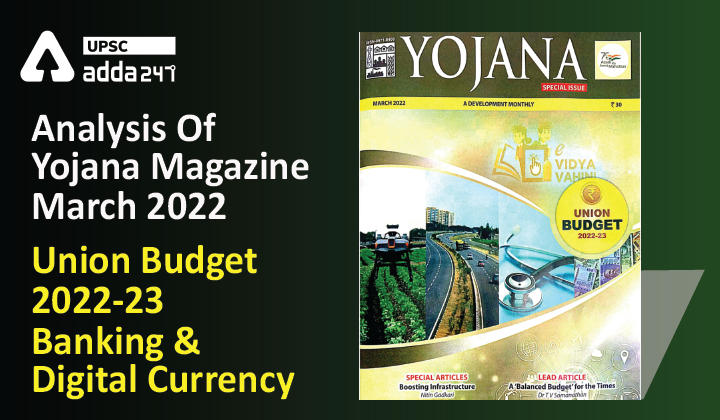Table of Contents
Analysis Of Yojana Magazine: ”Union Budget 2022-23 – Banking & Digital Currency
Relevance
GS 3: IT & Computers, Mobilization of Resources, Banking Sector & NBFCs, Statutory Bodies
Introduction
- More credit lines for small businesses, introduction of the central bank digital currency, digital banking push, and amendments to strengthen the bankruptcy law were among key focus areas for the banking sector in this year’s Union Budget.
- The committee set up by the government to examine the policy and legal framework for the regulation of virtual/cryptocurrencies recommended the introduction of CBDCs in India. On this line, FM announced that RBI will be launching its own digital rupee in the financial year 2022-23.
- About 1.5 lakh post offices are proposed to come on to the core banking system enabling financial inclusion.
- It is proposed to set up 75 Digital Banking Units (DBUs) in 75 districts of the country by SCBs.
- The Budget has also continued support for the digital payment ecosystem and the focus will be to promote the use of economical and user-friendly payment platforms.
5 Major Announcements
- Continuous financial support to digital payments.
- Digital banking unit.
- Core banking system in post offices.
- New taxation system for virtual digital assets like cryptocurrency.
- Central bank digital currency.
How did the Banking Sector perform in the previous fiscal?
- The banking sector has performed well as the capital adequacy ratios have improved and non-performing assets have reduced.
- Capital to risk-weighted asset ratio (CRAR) of SCBs increased from 15.84% at end-September 2020 to 16.54% at end-September 2021, on account of improvement of CRAR of both public and private sector banks.
- The Gross Non-Performing Advances (GNPA) ratio of Scheduled Commercial Banks (SCBs) decreased from 7.5% at the end-September 2020, to 6.9% at end-September 2021, whereas restructured standard advances (RSA) ratio increased from 0.4% to 1.5% during the same period.
What is the Reserve Bank of India – Digital Payments Index (RBI-DPI)?
- The Reserve Bank had announced a composite Reserve Bank of India – Digital Payments Index (RBI-DPI) with March 2018 as base to capture the extent of digitisation of payments across the country.
- The index for September 2021 stands at 304.06 against 270.59 for March 2021.
- The RBI-DPI Index continues to demonstrate significant growth in adoption and deepening of digital payments across the country.
About Central Bank Digital Currency (CBDC)
- Reserve Bank of India (RBI) launching its own digital rupee in the financial year 2022-23. This Digital Rupee is a central bank digital currency.
- CBDC or Central Bank Digital Currency is a legal tender issued by the Reserve Bank of India.
- A CBDC is an electronic record or digital token of a country’s official currency, which fulfils the basic functions as a medium of exchange, unit of account, store of value, and standard of deferred payment.
- It is a sovereign currency in an electronic form and will appear as a liability (currency in circulation) on a central bank’s balance sheet. CBDCs should be exchangeable at par with cash.
- It is being explored by central banks across the world. China has tested proof of concept for e-Yuan while the US Federal Reserve has solicited public comments on its proposed foray into digital dollar – the sovereign digital currency.
- The Digital rupee will be introduced by RBI starting 2022-23, using blockchain and other technologies. With this India will join the select few major global economies to have its own sovereign digital currency.
IBC Amendments
- FM announced some proposed changes in the Insolvency and Bankruptcy Code (IBC) to enable seamless cross-border insolvency, as well as quicker dispute resolution.
- Necessary amendments will be made in the IBC for more efficient dispute resolution and enable cross-border insolvency resolution.
- FM announced that voluntary winding up would be expedited to reduce the exit timeline from 2 years to 6 months.
Conclusion
The Budget 2022-23 seeks to lay the foundation and give a blueprint to steer the economy over the coming years with an impetus for growth. The banking sector is an important component of the economy’s growth engine which will play an important role in meeting budgetary objectives.



 TSPSC Group 1 Question Paper 2024, Downl...
TSPSC Group 1 Question Paper 2024, Downl...
 TSPSC Group 1 Answer key 2024 Out, Downl...
TSPSC Group 1 Answer key 2024 Out, Downl...
 UPSC Prelims 2024 Question Paper, Downlo...
UPSC Prelims 2024 Question Paper, Downlo...
